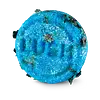What's inside
What's inside
 Key Ingredients
Key Ingredients

 Benefits
Benefits

 Concerns
Concerns

 Ingredients Side-by-side
Ingredients Side-by-side

Water
Skin ConditioningSodium Cocoyl Isethionate
CleansingCocamidopropylamine Oxide
CleansingCocamidopropyl Hydroxysultaine
CleansingGlycol Distearate
EmollientDisodium Laureth Sulfosuccinate
CleansingAcrylates Copolymer
Glycerin
HumectantTocopheryl Acetate
AntioxidantAscorbic Acid
AntioxidantLavandula Angustifolia Flower Extract
CleansingCitrus Reticulata Peel Oil
MaskingRosa Canina Fruit Oil
EmollientHydrolyzed Oat Protein
Skin ConditioningChamomilla Recutita Flower Extract
MaskingHelianthus Annuus Seed Extract
Skin ConditioningCamellia Sinensis Leaf Extract
AntimicrobialWheat Amino Acids
Skin ConditioningMelanin
Skin ProtectingLactic Acid
BufferingHydrolyzed Soy Protein
HumectantHydrolyzed Wheat Protein
Skin ConditioningHydrolyzed Oats
Skin ConditioningHydrolyzed Vegetable Protein Pg-Propyl Silanetriol
Skin ConditioningCaprylyl Glycol
EmollientPentylene Glycol
Skin ConditioningButylene Glycol
HumectantGuar Hydroxypropyltrimonium Chloride
Skin ConditioningSuperoxide Dismutase
AntioxidantLauryl Alcohol
EmollientGlycereth-26
HumectantDecyl Glucoside
CleansingSodium Lauroyl Sarcosinate
CleansingPolyquaternium-7
Polyquaternium-11
Polyquaternium-55
Malic Acid
BufferingAminomethyl Propanol
BufferingDisodium EDTA
Fumaric Acid
BufferingPhenoxyethanol
PreservativeEthylhexylglycerin
Skin ConditioningBenzoic Acid
MaskingPotassium Sorbate
PreservativeSodium Benzoate
MaskingLeuconostoc/Radish Root Ferment Filtrate
AntimicrobialCitric Acid
BufferingParfum
MaskingBenzyl Benzoate
AntimicrobialLimonene
PerfumingCI 17200
Cosmetic ColorantCI 19140
Cosmetic ColorantCI 42090
Cosmetic ColorantWater, Sodium Cocoyl Isethionate, Cocamidopropylamine Oxide, Cocamidopropyl Hydroxysultaine, Glycol Distearate, Disodium Laureth Sulfosuccinate, Acrylates Copolymer, Glycerin, Tocopheryl Acetate, Ascorbic Acid, Lavandula Angustifolia Flower Extract, Citrus Reticulata Peel Oil, Rosa Canina Fruit Oil, Hydrolyzed Oat Protein, Chamomilla Recutita Flower Extract, Helianthus Annuus Seed Extract, Camellia Sinensis Leaf Extract, Wheat Amino Acids, Melanin, Lactic Acid, Hydrolyzed Soy Protein, Hydrolyzed Wheat Protein, Hydrolyzed Oats, Hydrolyzed Vegetable Protein Pg-Propyl Silanetriol, Caprylyl Glycol, Pentylene Glycol, Butylene Glycol, Guar Hydroxypropyltrimonium Chloride, Superoxide Dismutase, Lauryl Alcohol, Glycereth-26, Decyl Glucoside, Sodium Lauroyl Sarcosinate, Polyquaternium-7, Polyquaternium-11, Polyquaternium-55, Malic Acid, Aminomethyl Propanol, Disodium EDTA, Fumaric Acid, Phenoxyethanol, Ethylhexylglycerin, Benzoic Acid, Potassium Sorbate, Sodium Benzoate, Leuconostoc/Radish Root Ferment Filtrate, Citric Acid, Parfum, Benzyl Benzoate, Limonene, CI 17200, CI 19140, CI 42090
 Reviews
Reviews

Alternatives
Ingredients Explained
These ingredients are found in both products.
Ingredients higher up in an ingredient list are typically present in a larger amount.
Ci 42090 is a synthetic dye created from petroleum. It is used to give a bright blue color to cosmetics, medicine, and food.
Citric Acid is an alpha hydroxy acid (AHA) naturally found in citrus fruits like oranges, lemons, and limes.
Like other AHAs, citric acid can exfoliate skin by breaking down the bonds that hold dead skin cells together. This helps reveal smoother and brighter skin underneath.
However, this exfoliating effect only happens at high concentrations (20%) which can be hard to find in cosmetic products.
Due to this, citric acid is usually included in small amounts as a pH adjuster. This helps keep products slightly more acidic and compatible with skin's natural pH.
In skincare formulas, citric acid can:
While it can provide some skin benefits, research shows lactic acid and glycolic acid are generally more effective and less irritating exfoliants.
Most citric acid used in skincare today is made by fermenting sugars (usually from molasses). This synthetic version is identical to the natural citrus form but easier to stabilize and use in formulations.
Read more about some other popular AHA's here:
Learn more about Citric AcidLimonene is a fragrance that adds scent and taste to a formulation.
It's found in the peel oil of citrus fruits and other plants such as lavender and eucalyptus. The scent of limonene is generally described as "sweet citrus".
Limonene acts as an antioxidant, meaning it helps neutralize free radicals.
When exposed to air, oxidized limonene may sensitize the skin. Because of this, limonene is often avoided by people with sensitive skin.
The term 'fragrance' is not regulated in many countries. In many cases, it is up to the brand to define this term. For instance, many brands choose to label themselves as "fragrance-free" because they are not using synthetic fragrances. However, their products may still contain ingredients such as essential oils that are considered a fragrance.
Learn more about LimoneneParfum is a catch-all term for an ingredient or more that is used to give a scent to products.
Also called "fragrance", this ingredient can be a blend of hundreds of chemicals or plant oils. This means every product with "fragrance" or "parfum" in the ingredients list is a different mixture.
For instance, Habanolide is a proprietary trade name for a specific aroma chemical. When used as a fragrance ingredient in cosmetics, most aroma chemicals fall under the broad labeling category of “FRAGRANCE” or “PARFUM” according to EU and US regulations.
The term 'parfum' or 'fragrance' is not regulated in many countries. In many cases, it is up to the brand to define this term.
For instance, many brands choose to label themselves as "fragrance-free" because they are not using synthetic fragrances. However, their products may still contain ingredients such as essential oils that are considered a fragrance by INCI standards.
One example is Calendula flower extract. Calendula is an essential oil that still imparts a scent or 'fragrance'.
Depending on the blend, the ingredients in the mixture can cause allergies and sensitivities on the skin. Some ingredients that are known EU allergens include linalool and citronellol.
Parfum can also be used to mask or cover an unpleasant scent.
The bottom line is: not all fragrances/parfum/ingredients are created equally. If you are worried about fragrances, we recommend taking a closer look at an ingredient. And of course, we always recommend speaking with a professional.
Learn more about Parfum